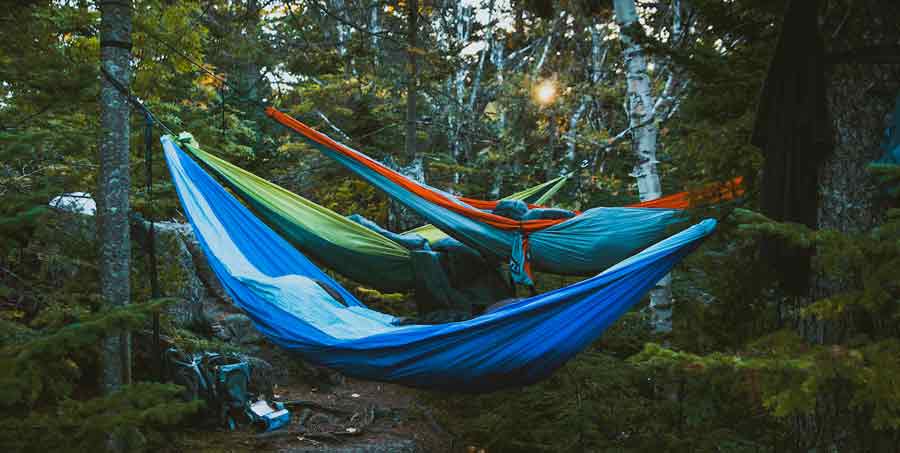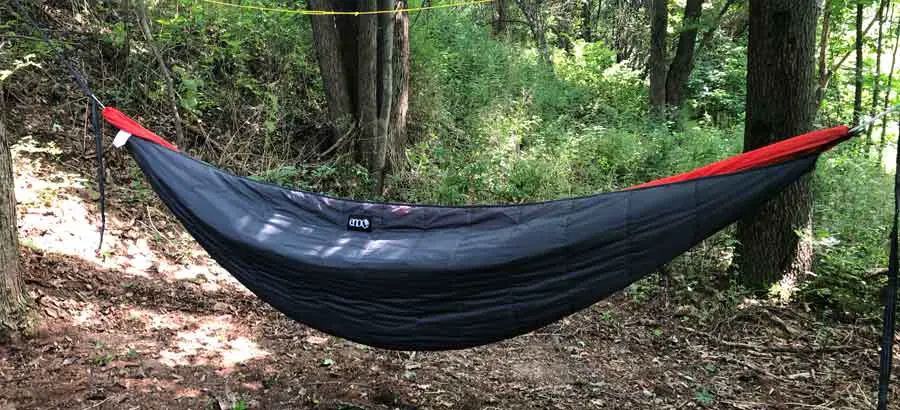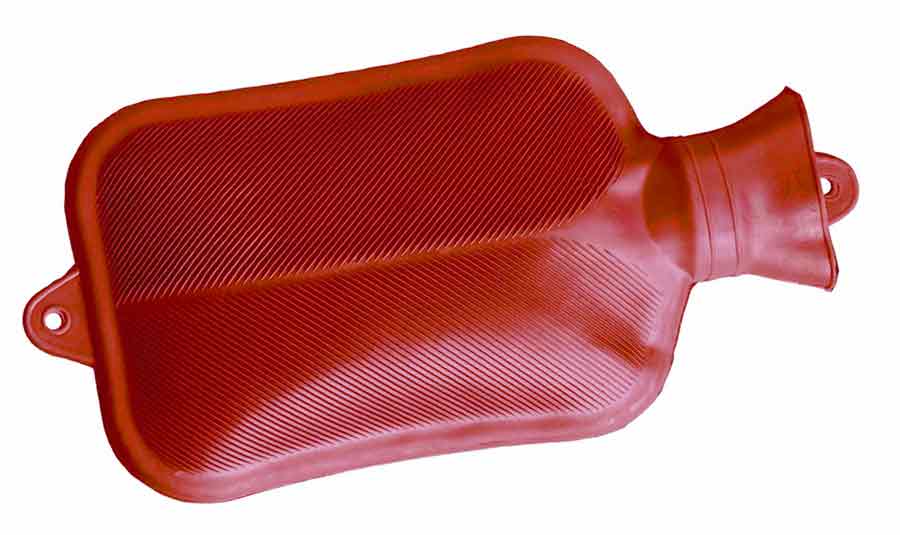Sleeping bag alternatives for insulation
Sleeping bags don’t have to be your only option for insulation. If you don’t want to use a sleeping bag, there are other alternative insulators to consider. The important thing is that the insulator of choice actually works and keeps you warm. There’s no right or wrong insulation system, so do what works well for you.

So here are a few options that I’ve researched. If I come across any others, I will be sure to update this post.
Underquilts
The underquilt is perhaps the most commonly talked about method of insulating your hammock. An underquilt is essentially a sleeping bag that wraps around the underside and hangs below your hammock on the outside. It protects against the cool air flowing under and around you. It hangs down a little lower than the hammock to create a gap for an air pocket. Throughout the night, your body heat warms the air in the gap between you and the underquilt protecting you from the cooler outside temperatures.

Like sleeping bags, underquilts can be bulky and difficult to carry if you are a backpacker trying to carry as little weight as possible. If I am going backpacking and it’s going to be cold, I will sacrifice other things in my pack in favor of my underquilt. It’s definitely worth the sacrifice when I am warm in my hammock and not freezing my butt off. If you car camp or camp somewhere where you aren’t carrying your gear far distances, an underquilt is a great option.
I use and love my underquilt. It keeps me nice and cozy all night long. Although I’ll admit, it is a little on the pricey side and I did have to save up before I got one. I’m currently saving up to buy my two boys their own.
I did a full review of my favorite hammock underquilt. I’ve tested this underquilt over many cold nights. Read my review here: ENO Ember 2 Hammock Underquilt
Sleeping Pads
Sleeping pads are a popular alternative to combat the cold. They are typically used for ground camping, but can successfully be used for hammock camping as well. A good sleeping pad will provide a barrier and insulate you from the bottom of the hammock. However, you will need to ensure that you select the correct sleeping pad.
Always keep heat transfer through convection on your mind. If you have the wrong type of sleeping pad, you could end up still being cold because the pad you chose was not able to insulate enough against the airflow around your hammock. Self-inflating pads designed for ground camping may not do the trick in a hammock due to convection and the air inside the pad becoming cold. There are sleeping pads that are specifically designed for hammock use that work well. There are also some really great down-filled pads that provide good insulation. The sleeping pad you choose really just depends on your insulation needs.
The sleeping pad I use is extra-wide and pushes out the sides of the hammock so they are away from my face while I’m sleeping. It also gives me a little more room for my head and pillow. Some people swear by sleeping pads for these reasons. Space can get a little tight when you are cocooned in your hammock so every little bit of help you can get to spread out, the better.
As with anything, sleeping pads come with some drawbacks. In some instances, a sleeping pad may insulate you too well and cause you to sweat. Before you decide on a sleeping pad be sure to do your research. I have a pad that works well in most temperatures and it is my go-to in most situations. I know other hammock campers that have multiple sleeping pads to accommodate extreme temperatures – a lighter weight self-inflating pad for warmer temperatures, and a heavier insulated pad for really cold temperatures.
Reflective blankets
Personally, for me, reflective blankets are always a camping and hiking must-have in my bag. Reflective blankets go by a variety of names including Mylar blankets, emergency blanket, space blanket, first aid blanket, safety blanket, thermal blanket, heat sheet, or heat shield.
These blankets are made of a heat-reflective plastic and can greatly reduce the effects of convection. They are waterproof and windproof which significantly reduces the loss of body heat. The radiating heat from your body builds up inside the blanket (remember the air pocket) and keeps you quite warm. I have lined my hammock with these on extra cold nights and they do help. The best part is that reflective blankets are relatively inexpensive and ultra-lightweight.
Blankets
When I first started hammock camping, I used blankets instead of sleeping bags. However, it’s important that you keep in mind that my first few times camping in my hammock were on warm summer nights. If you select the right kind of blanket, it is possible to keep yourself warm. I went to an army surplus store and bought a really nice army issued wool blanket. It was thick and warm. A possible con to this method is the blanket isn’t lightweight and it adds a lot of weight to my load. If you’re not backpacking and don’t have to carry your gear for too long, this is a good alternative for those warmer nights. For colder nights, I would not recommend using only blankets as insulation.
You could also use a warm, thick blanket as a make-shift sleeping pad to add a buffer between you and your hammock. When I was still new to hammock camping, I used this method in combination with dressing in warm clothes. It was just enough to keep me comfortable. However, the nights that I used this method of insulation were still quite warm. It probably wouldn’t have worked well on a cooler night.

Warm Clothes
This might seem obvious, but hear me out. Most of our body heat is lost through our head and neck. Be smart and wear warm, protective clothing. If you are out in very cold weather, make sure you have clothing that will protect you against wind and water. However, be mindful of how breathable your clothing is as well. If you sweat a lot under the layers of clothing and the sweat cannot evaporate, you run the risk of the sweat freezing. No good. You will be risking hypothermia. Always be prepared and dress for the weather.
My general rule of thumb is to dress in layers. This way I am able to add and take away layers as I need to. I have been known to dress too warmly for the night and end up peeling off a layer or two at some point. The reverse is also true you can always add layers if you get too cold. A hoodie is always my go-to. No matter the outside temperature I always stick a hoodie in my hammock just in case I need it. If I get chilly in the night, I just throw it on and it does the trick to warm me back up.
Protection from the wind
A good, quality tarp can shield you from the wind and cut down greatly on the airflow around your hammock. If there isn’t any airflow, you have little to no convection. A good tarp in combination with the proper configuration will keep the airflow at bay. There are tarp configurations that if done right, look just like a tent. It provides great protection from the elements outside your hammock.

Miscellaneous Alternatives
There are a few other miscellaneous methods that you could also consider using for your insulation system.
You can use a good old fashioned hot water bottle. You know them, the rubber water bladder you put hot water in. These will keep you warm.
Another tip I read about is to place some stones next to your fire and then before you go to bed, roll the stones (safely!) under your hammock. This will help to warm the air under you. Be careful not to get the stones too close to your hammock though because nylon does melt. Also, be sure not to burn yourself, please. Safety first!
So Many Options
In short, you absolutely do not need to have a sleeping bag for hammock camping. There are many other options that can be used on their own or in combination with another. This mix and match of insulators should give you enough options to find the perfect fit for your needs.
I’m not going to lie, it is going to take some experimentation and a few uncomfortable nights to get your ideal insulation system figured out, but you will. You’ll likely even end up with a few different setups depending on the expected weather of your outing. Just be sure to keep a journal and document the weather and what insulation you used.
So there you go. I hope you found some useful nuggets in this post to help you find your ideal insulation system.
As always, I hope you stay warm and cozy in the Wanderful Wild.
